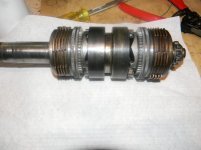I am having problems with the Matrix clutch on my Smart Brown 1024. Taking it out was a real PITA so I want to consider replacing any worn bronze wet plates. The steel plates all look good as i would expect. Original replacements from Matrix are still available but about $100 each and 10 are used. I found some replacements much cheaper from a Colchester lathe which also uses a Matrix clutch but they are slightly thinner .057 vs .061 for the original and have a cross hatched pattern embossed into them. They also are much rougher than the smooth old plates. If the originals are not worn and retain the same thickness, would you replace them with the new or retain them? Thanks, Dave
View attachment 308331
MUST be folks around - UK contingent, mayhap? - who have operated both lathes during their tenure?
My "question" would be whether the Matrix goods used in the Colchester were meant for and WERE - more abrupt - or less abrupt - as to clutch take-up than the Matrix goods in the S&B.
And/or .. if there were annoying issues as to wear or degrading performance known for either that might have prompted a change to the design?
IOW.. I class the difference as intentional, and engineering-driven, not cost-driven. The production cost difference would not have been large.
Ergo regard the difference as significant.. and to a purpose.
Will it matter? Guess that depends on how badly worn if not adopted as a probable improvement.
As to the $100 cost? EACH?
Almost certainly the diameter is not a match, but still..
A Rockwell "New Departure Model DD" two-speed bicycle coaster brake I had in the late 1950's used identical LOOKING alternating steel and Bronze plates for braking. As did other coaster brakes without the planetary geared 1.1:1 overdrive.
New sets were CHEAP from Sears-Roebuck, too!
Dave?
It would be
seriously amusing if ignorant
bicycle parts DID fit your Matrix clutch ...and save the better part of that possible thousand dollar outlay!!!






